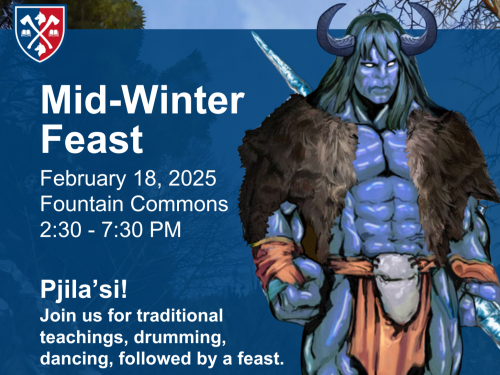Celebrate Midwinter Feast at Acadia
by Ashley Cyr

You may have noticed that though the winter weather is still severe, now, when you leave your classes at the end of the day, the sun is well above the horizon. We’re over the hump, and the most difficult part of the winter is coming to an end.
We have gotten through the worst of the worst, and we are grateful for all the things that kept us going through the bitterly cold months.
This is what the Midwinter Feast celebrates. Essentially, according to Elder Dr. Gerald Gloade, “it’s sort of like the Mi’kmaw version of Groundhog Day.”
On February 18, we invite all campus and community members to enjoy a meal, enjoy traditional teachings, drumming, and dancing together to celebrate the impending end of snowy days.
While the Midwinter Feast was an important part of Mi’kmaq annual celebrations since well before European contact, it was banned under the Indian Act in the 1800s and only revived within the last few decades.
As a result of its attempted erasure, it may be less familiar to the Acadia community. So, we called on Zabrina Whitman (Executive Advisor, L’nu Affairs and Indigenization) to fill us in on what the Midwinter Feast means and how we’re celebrating at Acadia. Here’s what she had to say.
----
What is the Midwinter Feast?
The Midwinter Feast is a tradition that has existed prior to European contact. The purpose of the Midwinter Feast is to celebrate having survived the harshest parts of winter and coming together as a community to feast and give thanksgiving for the blessings of life, health, and sustenance. The Midwinter Feast is connected to the celebration of Apuknajit (A-boog-n-awe-jit), a Mi’kmaw wizard and shape-shifter. On January 31st or February 1st, Mi’kmaq offer thanks to Apuknajit in hopes that he will be kind and bring a shorter winter.
Mi’kmaq were banned from practicing the Midwinter Feast under the Indian Act starting in the 1800s. The event was revived by the late Elder and Educator Lillian Marshall of Potlotek. Thanks to Lillian, this event is now celebrated across Mi’kma’ki. Acadia University hosted its First Midwinter Feast in Winter 2019.
Why is it in February?
The Midwinter Feast is lunar. This means the Midwinter Feast changes every year. For some, they celebrate it around the first full moon in February, while others celebrate it near the new moon. In other cases, some prefer to hold their Feast at the start of February. At Acadia University, we follow the practices of what Glooscap community members do, which is to celebrate it with the first full moon.
Who is welcome to the event?
Everyone. Of any age. The event is open to the Acadia campus community, and the surrounding local communities. This Feast is all about appreciating our neighbours and giving celebration that we’ve all, hopefully, made it through the darkest coldest days of winter.
What will happen at the Event?
We have esteemed Elder Dr. Gerald Gloade who will speak about the Midwinter Feast at 4pm. If you want to learn more about this beautiful tradition come out to hear him speak.
Then at 5pm we’ll have a feast of traditional foods that are meant to warm the belly. In Mi’kmaw culture, food is an important part of gathering. You should leave the event feeling full and having met new people and made new friends. That is what this event is about.
This year we’ll also have a vendor fair starting at 2:30pm. For folks on campus who won’t be able to make it to the feast but want traditional artisan work made by Mi’kmaq community members, come out and check what they have to offer.
----
We look forward to celebrating making it through another winter and the imminent arrival of warmer days. Hope to see you there!
